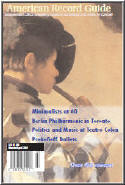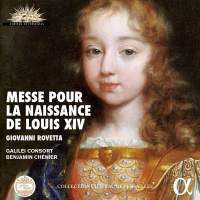Texte paru dans: / Appeared in: |
|
|
Outil de traduction ~ (Très approximatif) |
|
|
Reviewer: Charles
Brewer
In 1638, Amelot de la Houssaye,
the French ambassador to Venice, arranged for a solemn high Mass at the
Church of St George to celebrate the birth of Louis XIII and Anne of
Austria’s first son, the Dauphin Louis, later Louis XIV. The ambassador
commissioned Giovanni Rovetta (1596-1668) to supply most of the music, which
the composer duly published in 1639, dedicated to Louis XIII. This new
release, made at a concert in the chapelle royale at Versailles, is a
reconstruction by Benjamin Chenier of that Mass based on Rovetta’s
publication and chronicles at the time.
Rovetta, the deputy maestro
di cappella at the Basilica of San Marco, was clearly influenced by his
superior, Claudio Monteverdi, especially the works later printed in the
older master’s Selva Morale e Spirituale in 1640, both in terms of
musical style and instrumentation. The sensitive text settings (sometimes
repeating and reordering the liturgical text) demonstrate Rovetta’s
understanding of Monteverdi’s seconda prattica. Only the Kyrie,
Gloria, and Credo were composed for the Mass, since the Sanctus and Agnus
Dei movements would have been breve more Veneto (in the short
Venetian manner), because the Venetians preferred to have more interesting
vocal concertos and instrumental music in this part of the Mass. To fill
this lacuna Chenier took these short movements and an instrumental sonata
(together lasting only 7:24) from a 1640 publication by Giovanni Antonio
Rigatti. For the other parts of the Proper of the Mass missing in Rovetta’s
publication, Chenier made intelligent choices from Rovetta’s smaller vocal
works, added two short motets by Monteverdi (‘Christe adoramus te’ performed
by instruments, and ‘Adoramus te, Christe’), and a final motet, ‘Omnes
gentes plaudite manibus’, by the leader of the instrumentalists at San
Marco, Giovanni Bassano.
While there are single
concerted motets by Rovetta in various recorded collections of Venetian
sacred music from the early 17th Century, the only previous
complete recording was of the Vespers music from his 1639 publication
(Sept/Oct 2008). The music for the Vespers psalms requires a smaller
instrumental ensemble, and Junghänel follows the one-perpart performance
practice. Because Rovetta’s Mass has a clear solo-tutti contrast, Chenier
adds a tutti choir of six voices to the core group of eight solo singers.
Rovetta’s Credo was included on Andrew Parrott’s reconstruction of the
Venetian Mass of Thanksgiving from 1631 (Sept/Oct 1994) but three sections
were replaced by Monteverdi’s compositions. Parrott also used a much larger
vocal ensemble, so the solo-tutti contrast is much stronger. This type of
strong contrast is also evident on the complete recording of Rigatti’s Mass
with a 40-voice chamber choir (Mar/Apr 1999). The performance is of a very
high standard by both vocalists and instrumentalists. This is not a full
liturgical reconstruction (as in Parrott’s) since some of the chanted
portions and liturgical readings are missing. Chenier’s essay is
instructive, and full texts and translations are included. But this was a
concert—and the applause was a bit of a shock at the end. | |
|
|
|
|
|
|
|
Cliquez l'un ou l'autre
bouton pour découvrir bien d'autres critiques de CD |
|




